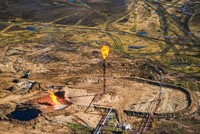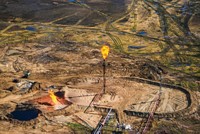Advertisement
Grab your lab coat. Let's get started
Welcome!
Welcome!
Create an account below to get 6 C&EN articles per month, receive newsletters and more - all free.
It seems this is your first time logging in online. Please enter the following information to continue.
As an ACS member you automatically get access to this site. All we need is few more details to create your reading experience.
Not you? Sign in with a different account.
Not you? Sign in with a different account.
ERROR 1
ERROR 1
ERROR 2
ERROR 2
ERROR 2
ERROR 2
ERROR 2
Password and Confirm password must match.
If you have an ACS member number, please enter it here so we can link this account to your membership. (optional)
ERROR 2
ACS values your privacy. By submitting your information, you are gaining access to C&EN and subscribing to our weekly newsletter. We use the information you provide to make your reading experience better, and we will never sell your data to third party members.
Greenhouse Gases
Methane-monitoring satellites spot landfill superemitters
Remote monitoring helps researchers find facilities where methane mitigation should have huge climate impact
by Katherine Bourzac
August 17, 2022
| A version of this story appeared in
Volume 100, Issue 29

Drawing on data from multiple methane-monitoring satellites, researchers have spotted four superemitting urban landfills that release unusually large amounts of the greenhouse gas. The data suggest that solid-waste methane emissions in Buenos Aires, Delhi, Lahore, and Mumbai are greater than previously estimated (Sci. Adv. 2022, DOI: 10.1126/sciadv.abn9683).
Researchers say the study shows the potential of an emerging network of satellites to spot sources of the climate-warming gas, which can help companies and regulators to find the most promising targets for mitigation. “You can’t manage what you don’t measure,” says Riley Duren, an engineer and earth scientist at the University of Arizona and CEO of Carbon Mapper, a nonprofit organization developing methane-monitoring satellites. Duren was not involved with the research.
Methane is a more potent greenhouse gas than carbon dioxide, and it’s shorter lived. That means efforts to mitigate methane emissions can have a relatively quick impact on the climate. Decomposition of organic matter in landfills accounts for about 10% of anthropogenic methane emissions, and the amount of waste humans produce is growing faster than the world’s population.
The research team started by looking for urban methane hot spots using the Tropospheric Monitoring Instrument (TROPOMI), which is housed on a European Space Agency satellite. TROPOMI covers the entire globe, says study leader Joannes “Bram” Maasakkers, an atmospheric scientist at SRON Netherlands Institute for Space Research. With a spatial resolution of 7.5 km by 5 km, TROPOMI can find hot spots but not pinpoint the facilities where the emissions originate.
Maasakkers’s group then zoomed in using a suite of satellites operated by Canadian company GHGSat. The satelliteshave high spatial resolution of about 25 m2 but can only image small areas at a time, so “they need to know where to look,” Maasakkers says.
By using TROPOMI data to guide GHGSat to the hot spots, the team found that “the urban areas we looked at were emitting more methane than previous estimates,” he says. “Landfills made a significant contribution.” The largest of the four superemitters was a landfill in Buenos Aires, which was producing about 29 metric tons (t) of the greenhouse gas per hour when the researchers aimed the satellite on it in 2021.
Duren says the landfills identified in the study could be improperly operated facilitiesor open waste dumps where mitigation measures have not been implemented. For example, operators could cover landfills and divert the methane to sell as natural gas, or flare it.
However, the necessary capital investments can be significant, Duren says. He says satellite data can help low-income countries prioritize, pointing to where such investments will have the biggest impact.
Remote monitoring can spot unmanaged super emitters, but it’s also necessary to monitor the world’s managed landfills, Duren says. In previous work, Duren’s team found that landfills in California were the predominant point source of methane emissions in the state, ahead of the oil and gas sector and agriculture (Nature 2019, DOI: 10.1038/s41586-019-1720-3). In 2023, Carbon Mapper will be launching a constellation of satellites that will monitor 90% of the world’s landfills.
Maasakkers says his team is continuing to use TROPOMI to guide high-resolution imaging of methane hot spots around the world. “We hope this information can help bring these emissions down,” he says.
UPDATE
This story was updated on Aug. 24, 2022, to clarify that Carbon Mapper is a nonprofit organization. The original article described it as a company.





Join the conversation
Contact the reporter
Submit a Letter to the Editor for publication
Engage with us on Twitter